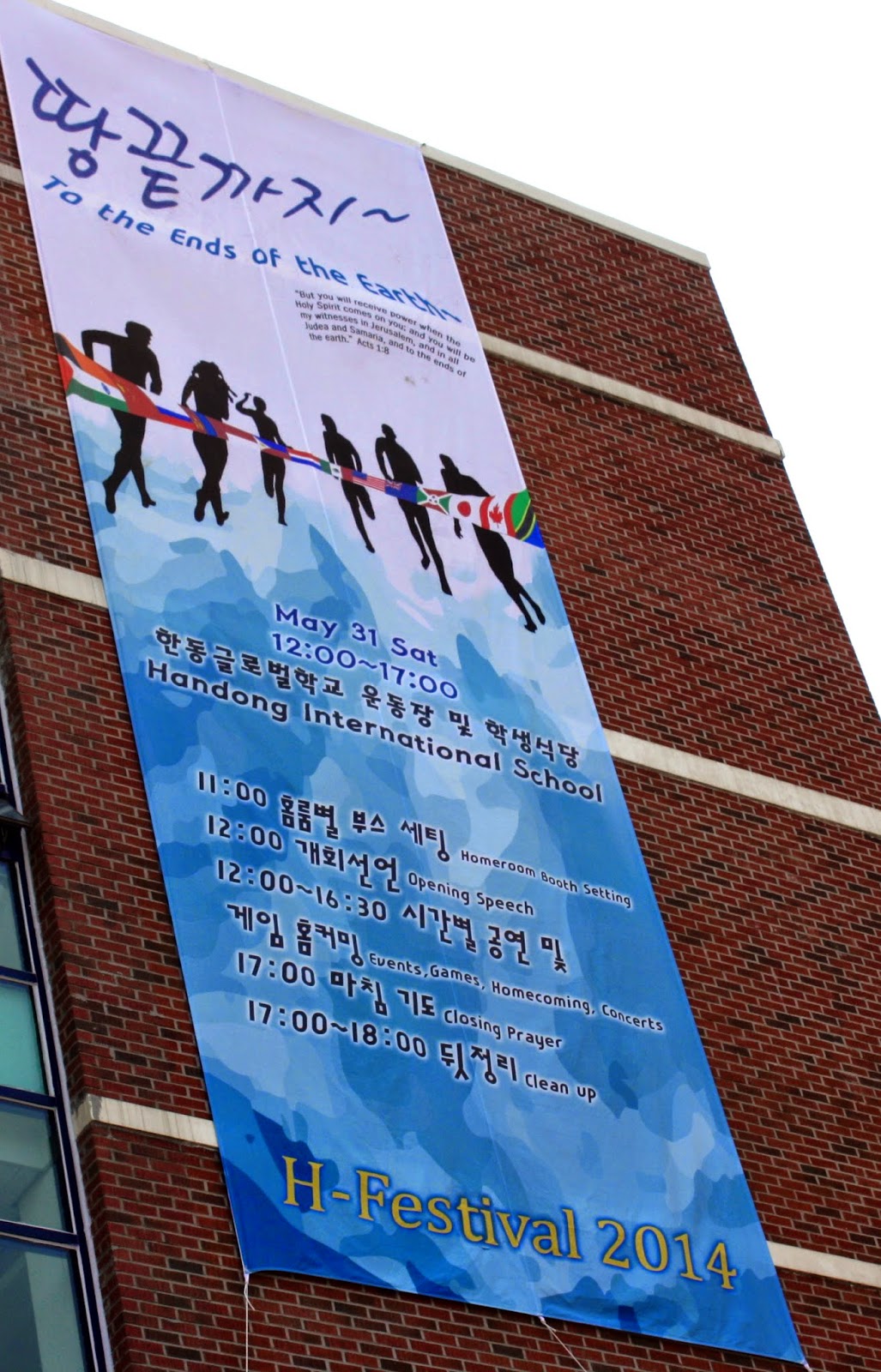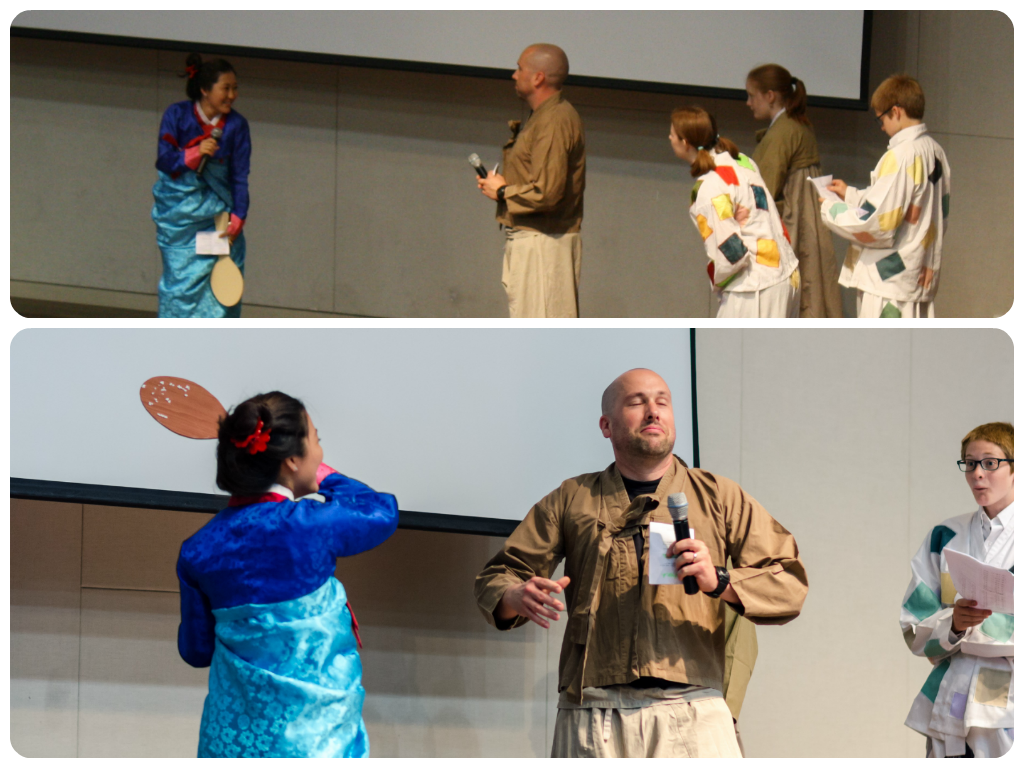 Nick told me two weeks ago of his Very Important Department Dinner With Spouses (one spouse would even be coming All the Way from Seoul!). The subtext was, well, not very sub-tle: I had to go. Nick had even written this event on the family calendar to forestall any line of excuses related to
Nick told me two weeks ago of his Very Important Department Dinner With Spouses (one spouse would even be coming All the Way from Seoul!). The subtext was, well, not very sub-tle: I had to go. Nick had even written this event on the family calendar to forestall any line of excuses related to So, after heroically
The Set-Up:
 |
| PSY advertising soju and beer. |
The Unfolding
(a) The banchan (small side dishes) were served, and lots of chatting in Korean ensued around the table. I tried to look pleasantly attentive and was inordinately pleased to understand key concepts like "then" and "thank you" and "ha ha ha." Given my staggering facility with spoken Korean language, I completely missed that the department chair had begun prayer. Oops. Then, head bowed and listening hard to the main prayer and all the side prayers (Koreans like to mumble along), I further failed to realize when prayer had ended. Perhaps I earned a bonus point for my apparent extra piety.
(b) In what appears to be the Korean Way, the host (department chair) must have ordered all the food for the table (who knew that ordering my very own restaurant food would be something I'd miss from the US?). A veritable march of banchan and main dishes appeared over the next two hours (see Appendix for specifics). Some items looked positively alarming; I noticed that Professor N also avoided a few things (raw abalone intestine, among them), and I avoided eating any raw fish, certain I would gag noisily and thus get Nick fired. However, Professor N was quite insistent that I try some of the other items, using rhetorical approaches like "there is only one for each of us" and "they are very expensive." Ah, peer pressure. Just what I needed.
(c) Despite my reluctance to put oh-so-recently-living-things in my mouth under the heading of "food," I found plenty of other items to keep me happily fed and looking sociable. At least, I thought so, until Professor N casually asked if I like abalone soup (uh, no, but I do love the pretty shells I find on the beach). Why do you ask, I wondered? Because the department chair had apparently noticed I wasn't partaking of the (expensive) raw fishes, so he had ordered that kind of soup for me. Noting my ill-disguised alarm, Professor N told the chair that I don't like seafood and don't eat it (that Korean exchange I understood). So, again without consulting me, he canceled the abalone soup and instead ordered a vegetarian noodle soup. When it arrived, Professor N indicated this soup was made especially for me since this type normally has lots of raw fish bits floating on top, a specialty of this particular fancy-schmancy restaurant. Ah, of course. And now I knew for sure that the chair was watching me, despite his near-obsessive phone behavior and ripping of the table-plastic with his restless thumbnail.
(d) I am proudly able to hold and use chopsticks for short periods of time to nab small, solid foods. However, when the soup arrived, I realized I could not possibly eat the coiled-up 1.32km long, thin noodles with just the slippery metal chopsticks, as the natives do. I did try, dear reader, splattering myself and who knows what else as I twisted the noodles around the chopsticks and around the spoon and around the chopsticks some more until my hand ached. Being kind, Professor N asked the staff for a fork. (Yes, a fork, for noodle soup.) Now I had THREE implements with which to battle the noodles while trying to seem competent and polite and not a slob.
 (e) Did I mention that earlier in the day I had dyed some t-shirts a lovely deep navy? Well, lacking rubber gloves and the patience to go buy some, I instead used a plastic shopping bag that apparently leaked and thus my right hand was very, very blue during dinner. If nothing else, certainly that impressed Nick's colleagues. Maybe they all ran home and wrote their own blogs about the American Moron at dinner.
(e) Did I mention that earlier in the day I had dyed some t-shirts a lovely deep navy? Well, lacking rubber gloves and the patience to go buy some, I instead used a plastic shopping bag that apparently leaked and thus my right hand was very, very blue during dinner. If nothing else, certainly that impressed Nick's colleagues. Maybe they all ran home and wrote their own blogs about the American Moron at dinner.(f) A food piece managed to stick to a blowing strand of my my hair, of which I didn't know until said hair entered my mouth and I found it impossible to retrieve while looking attentive and interested and possibly desperate for any English conversation. There were no napkins at the table to hide behind for an extraction process, and I was
 (g) Late in the meal, the department chair (via Professor N) asked if I wanted a cola. I was paranoid: he knew I'd rejected the expensive fancy fish foods, he knew I didn't want the abalone soup, that I didn't eat much of the soup that did show up (it WAS tasty, I kept insisting; I just wasn't skilled enough to eat it politely), and now he was trying to appease me with soda. No, no, I insisted. I am fine, thank you so much. Water is just fine. Fine. And moments later, out from the kitchen appeared glass bottles of Coke and Sprite for every person at the table...except me. Because I just wanted water. *sigh.* I felt I should join "Dolly" and her friends on the Island of Misfit Toys.
(g) Late in the meal, the department chair (via Professor N) asked if I wanted a cola. I was paranoid: he knew I'd rejected the expensive fancy fish foods, he knew I didn't want the abalone soup, that I didn't eat much of the soup that did show up (it WAS tasty, I kept insisting; I just wasn't skilled enough to eat it politely), and now he was trying to appease me with soda. No, no, I insisted. I am fine, thank you so much. Water is just fine. Fine. And moments later, out from the kitchen appeared glass bottles of Coke and Sprite for every person at the table...except me. Because I just wanted water. *sigh.* I felt I should join "Dolly" and her friends on the Island of Misfit Toys.During the meal, one of Nick's colleagues offered him some translation on his left, and Professor N provided intermittent summaries on my right. These side conversations (and my attention-sucking food skirmishes) meant Nick and I didn't speak much during dinner. Once, though, Nick asked how I was doing. I had no way to respond honestly to him without utterly revealing myself to him and his entire department as a completely ridiculous person. But later, in reflection, and in the process of many drafts of this essay, I realized something new. Even as a shy person who undoubtedly will continue to struggle with social anxieties, I could see my great foolishness did not lay in raw-fish-squeamishness or sad chopstick etiquette, but in being frightened by a group of bumblers and sinners who are just as ridiculous as me.
If only I can remember this the next time something is written on the calendar.
_______________________
Appendix of Foods:
Banchan:Tortilla triangles (one each) topped with a maraschino cherry, bean sprouts, raw salmon, and (something chewy)
Dark, deep-fried sticky balls of sweet potato coated with sesame seeds
Breaded, deep-fried (BDF) something (tofu?) in crazy, jigsaw-like shapes
Plates of pickled something (pink), pickles, and pickled onions
Plates of shredded cabbage topped with BDF eel and pink yogurt sauce
Vegetable kimbap (bite-sized rolls of rice, seaweed, and veggies) (note: once the allotted one kimbap per person was gone, there wasn't another speck of rice to be found during the whole meal, which was a great pity as I had counted on that as a sure-fire filler).
Main Dishes:
Platters of transparently-sliced raw fish (I was reminded of how brains are sliced with microtomes for study under a microscope) with baskets of neatly-stacked red lettuce leaves and sesame leaves for wrapping the fish with some sauce. Leaf-wrapped food seems to be the only thing Koreans eat with their hands.
Plates of raw abalone, abalone intestines, and sliced sea squirt (see here for a humorous description of a sane man's first (and only) sea squirt food encounter).
Bowls of cold noodle soup, which is served as a baseball-sized sphere of thin noodles in a bowl with some diced scallions, sliced cucumber, and crumbled, dried seaweed; you pour in the icy cold red broth from a separate pitcher (sort of like a V8 slushy). This dish was served later to the whole table but they got all the raw fish that mine didn't have. It was accompanied by its own side dishes of kimchi (fermented cabbage with salty red pepper paste) and other unidentified things (one bowl looked suspiciously like deep-fried crawfish legs).
Plates of tempura sweet potato slices and tempura shrimp. The potatoes were fantastic; the shrimps pink/purples tails peeking out of the yellow/wheat tempura were scary.
Plates of a breaded, deep-fried fish-ish thing (bones still in) with some fruit cocktail arranged on the top.
Finally, heavy stone bowls of still-boiling tofu/seafood soup. I don't know if this was intended to be dessert or it's just a healthy send-off dish.












































